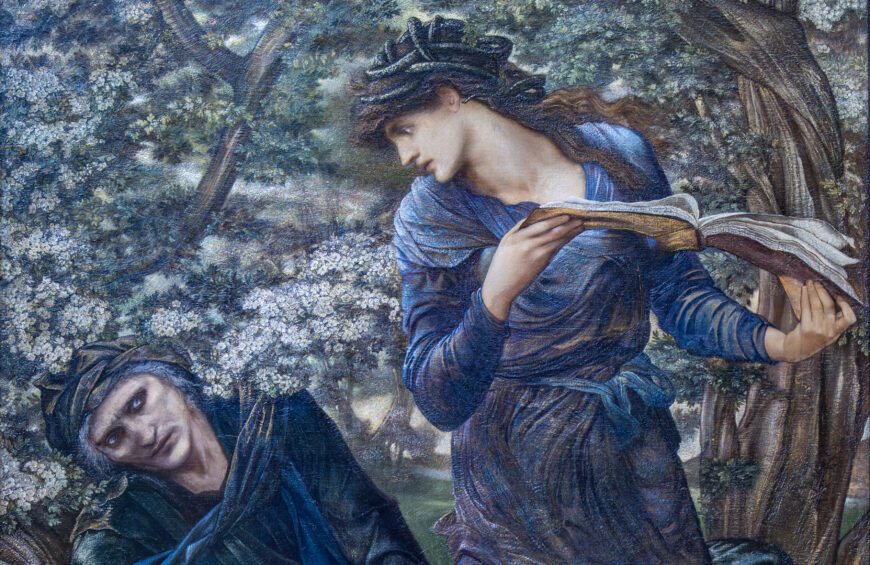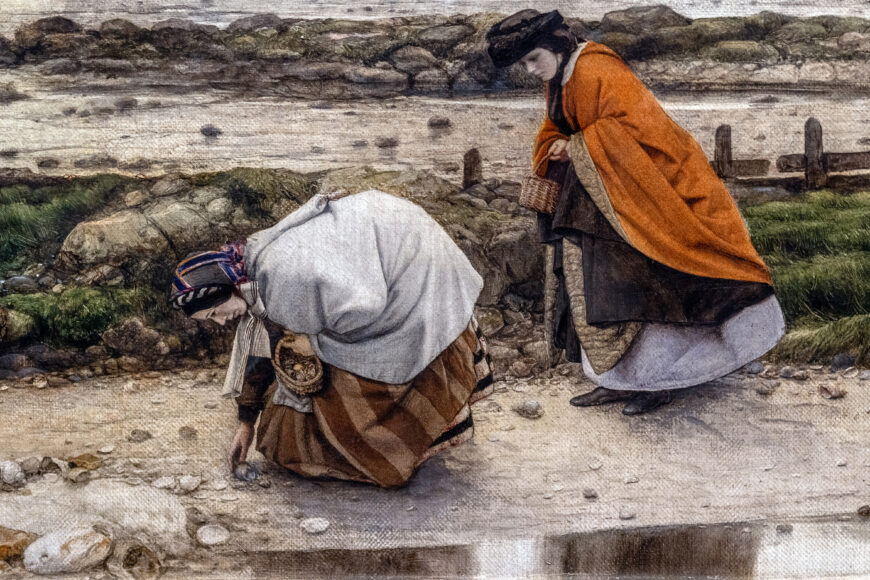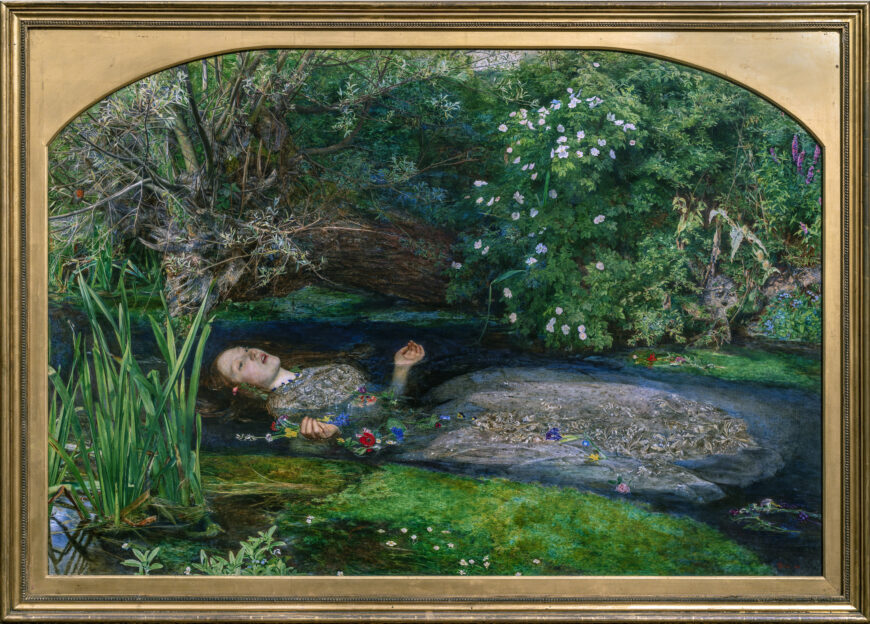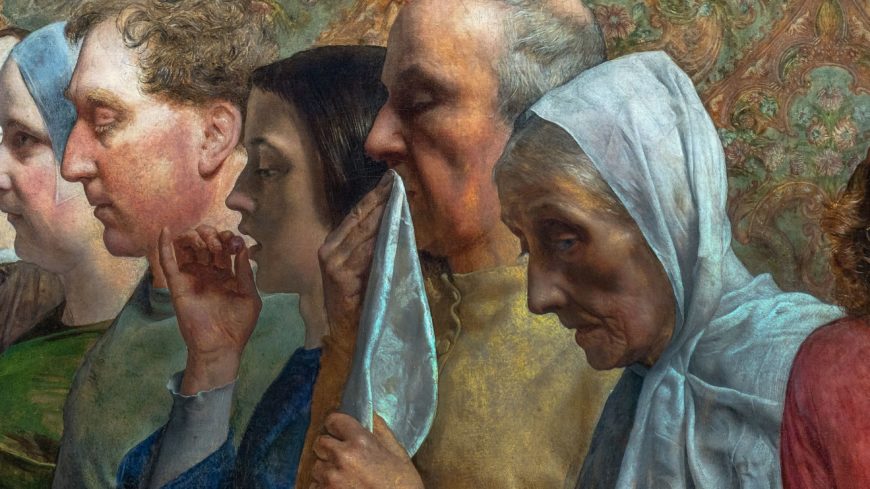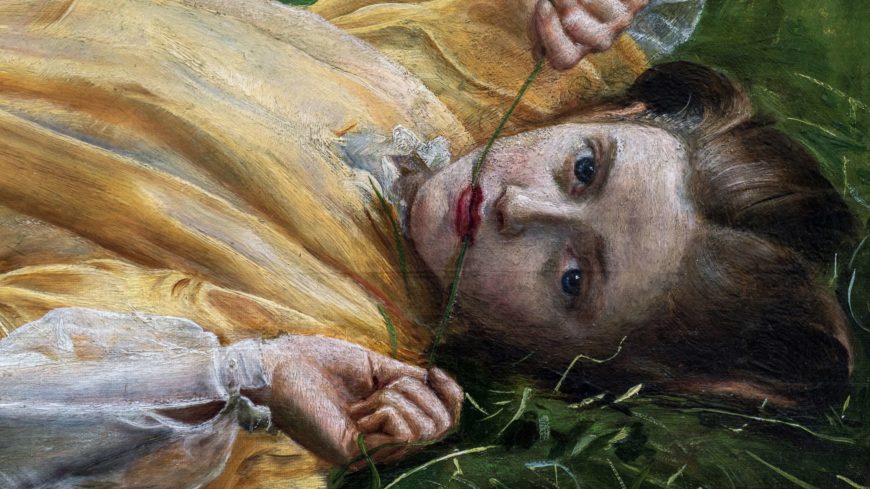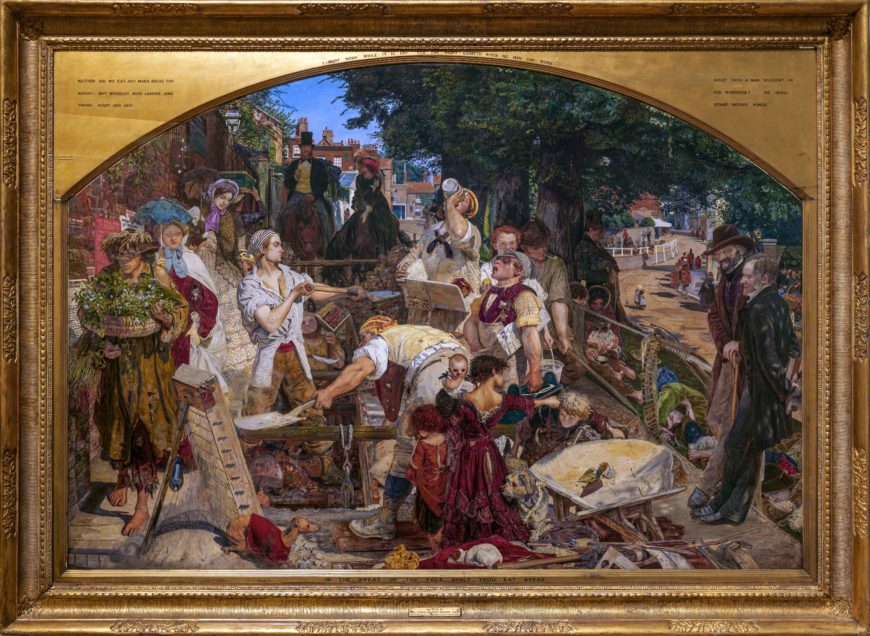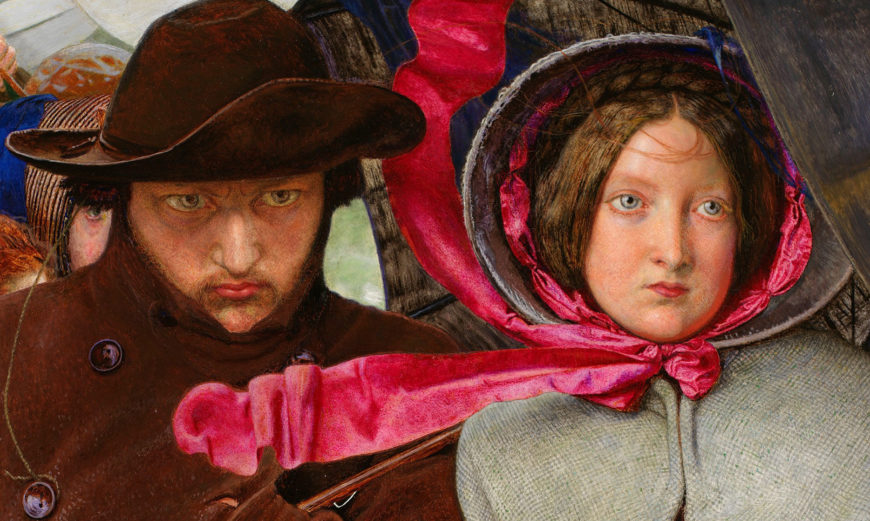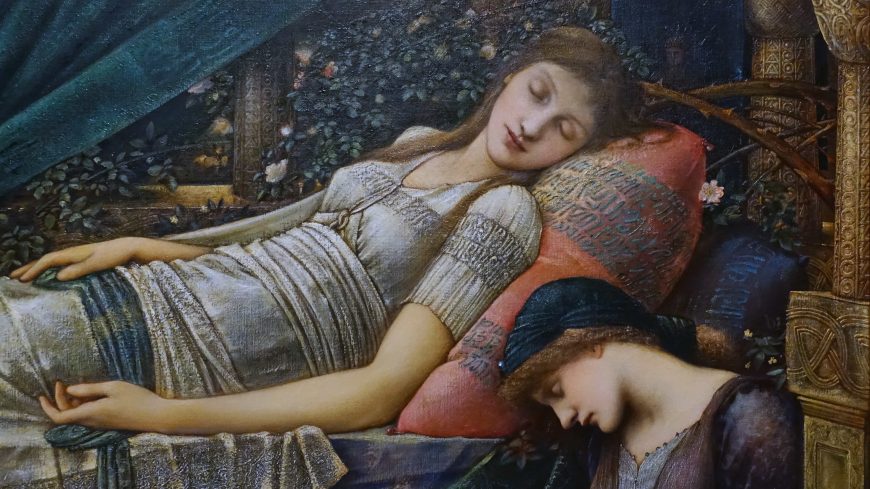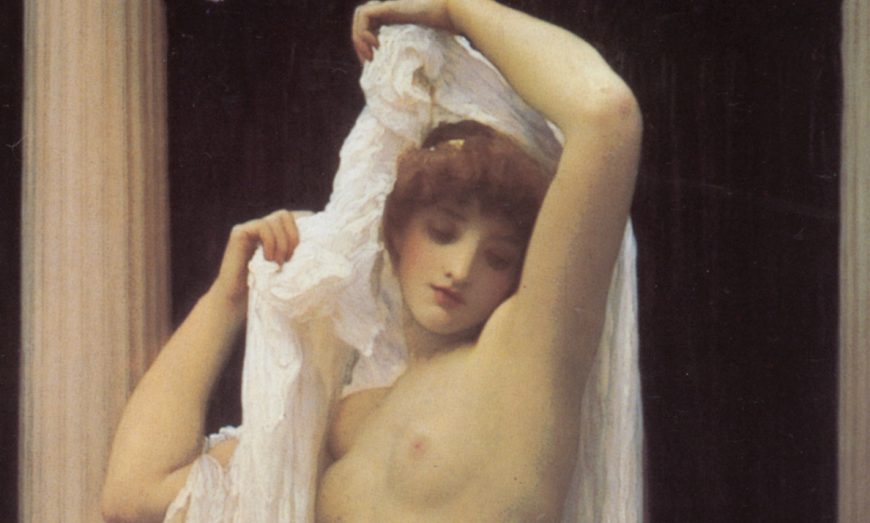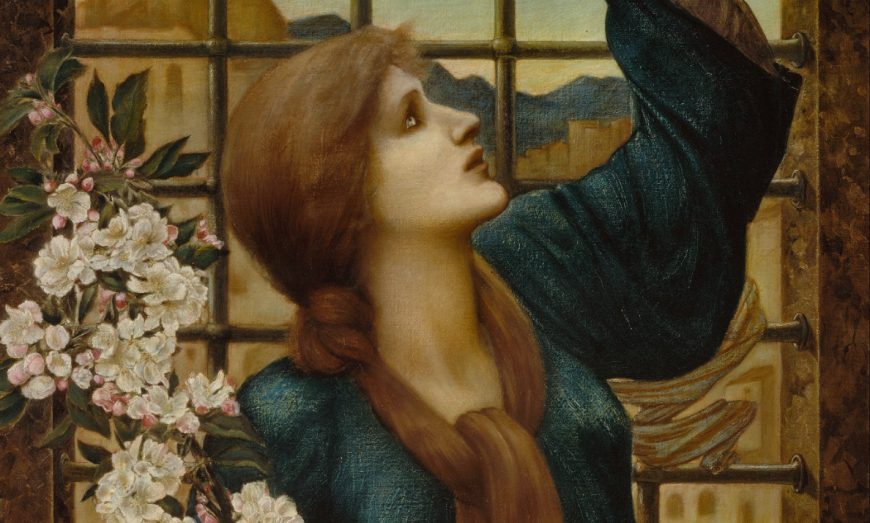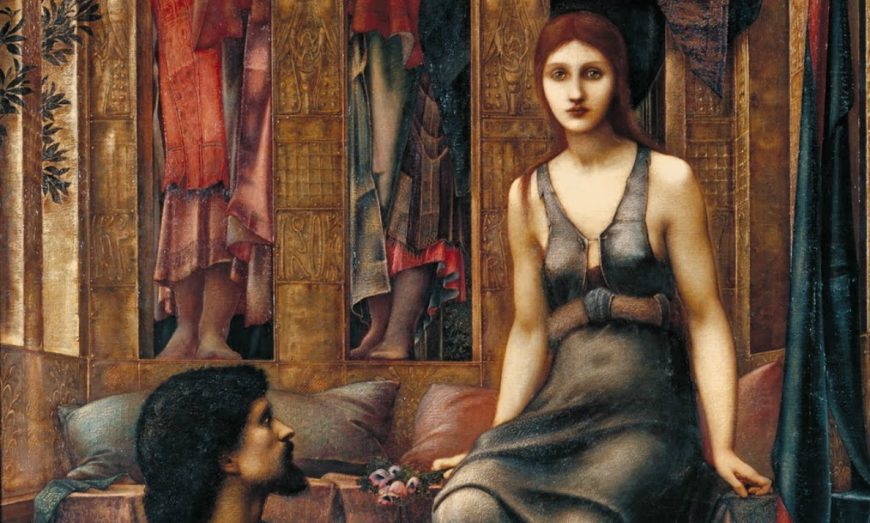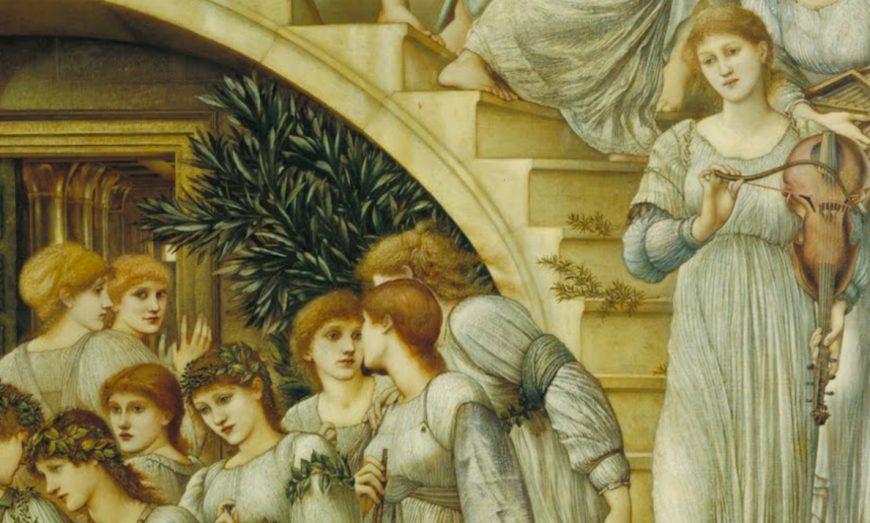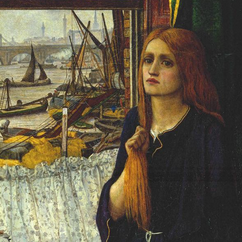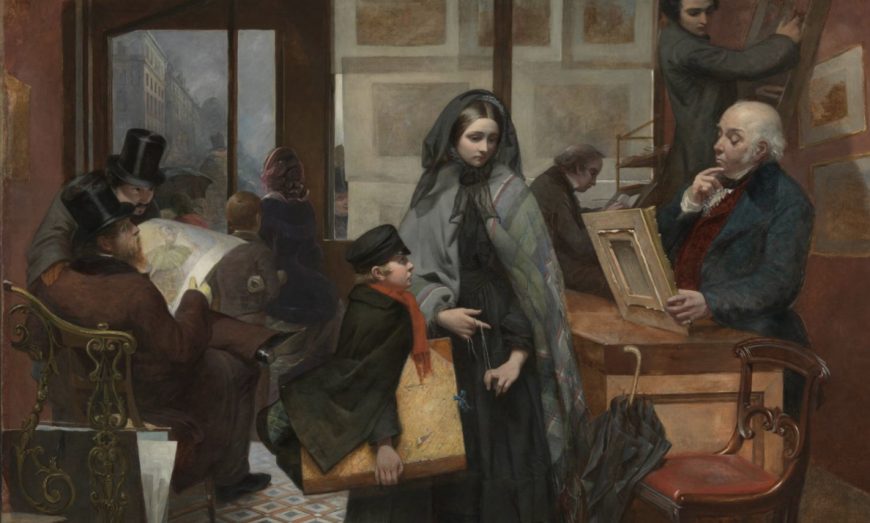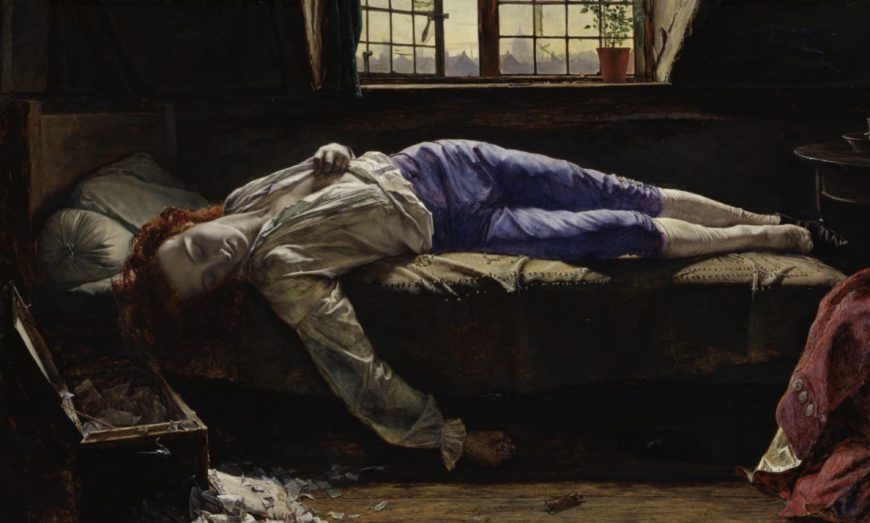This quiet, contemplative painting of nuns at a grave during an autumn sunset was the artist’s favorite.
Sir John Everett Millais, The Vale of Rest: where the weary find repose, 1858 (partially repainted 1862)
[0:00] [music]
Dr. Beth Harris: [0:04] We’re looking at Millais’ “The Vale of Rest” from 1858-59, and this is really Millais’ last painting in this Pre-Raphaelite style, his style will go on to become a little bit more academic, little bit more mainstream after this. We see two nuns, one seated while the other digs a grave in a graveyard.
Dr. Steven Zucker: [0:25] It’s unusual just for me to see a nun in such a specific physical activity, for one thing, but the other nun is in opposition to that. She’s really at rest. She’s looking directly out at us with a very powerful gaze.
Dr. Harris: [0:38] The way that she looks out at us with her hands folded, looking very peaceful, almost as though she has accepted death and mortality, and holds a rosary and a cross in her hand communicating the idea that it’s through Christ that one achieves eternal life, that one transcends earthly life.
[0:59] Even though there’s that clue to transcendence and eternity here for the human soul, we’re still really confronted with the terrible facts of death.
Dr. Zucker: [1:12] In the vividness of the soil and the gravestones.
Dr. Harris: [1:15] The idea of burial, and we’re essentially as viewers standing within the grave.
Dr. Zucker: [1:21] It’s so close to us, it’s true.
[1:23] There’s an interesting way in which the gravestones, the graveyard itself, is really bound, that we’re enclosed in this wall. I think one of the things that I find most beautiful about this painting is the really subtle use of light, that twilight is that moment. The sun is fading, creating these really glorious silhouettes for the trees and also creating this very soft and very complex light on the figures.
Dr. Harris: [1:47] Yeah, and it looks very real. You can really remember seeing light that looks exactly like this. This kind of golden light and the figures are backlit and light’s coming a little bit from the left. It almost creates halos…
Dr. Zucker: [2:00] It does. That’s right.
Dr. Harris: [2:00] …in a funny way around their heads.
Dr. Zucker: [2:03] In some ways, it plays with the colors in really interesting ways. You have those beautiful, very subtle colors in the sky, of course. Sort of cool, dark greens versus slightly warmer tones in some of the trees. Then the greens become so vivid in the grass, but there’s a kind of almost ethereal quality to the color that seems almost unnatural. We’ve all experienced this at twilight.
Dr. Harris: [2:25] Where the colors take on a kind of intensity.
Dr. Zucker: [2:27] Absolutely, but interestingly it’s almost more vivid than in a bright daylight, just because of the tonal contrasts I think.
Dr. Harris: [2:35] This is in a way a kind of modern memento mori. It’s not like Masaccio’s “Trinity” where we have a skeleton reminding us of death, connected to a religious painting. This is a secular image that’s been transformed into a painting with a spiritual message, reminding us of the passage of time, that death can come at any time to any one of us.
[3:00] In a way I wonder if it has a more secular message, too. Not so much that we better prepare for our salvation through Christ, but maybe also to enjoy and live life to its fullest while we have it.
Dr. Zucker: [3:15] So, through the beauty and the visual specificity, there’s a kind of real connection to the physical world, even though the message is very much about that transition.
[3:25] What I find really brilliant is that here, completely within the industrial world now, within our scientific world, the artist is able to re-imbue a direct physical sense of the spiritual in a way that seems very authentic, that doesn’t need any of the artifice of the Renaissance, of the Baroque, but is able to find a kind of spirituality within the modern world.
[3:47] [music]
Inspired by the sunset
An October sunset was the inspiration for the evocative The Vale of Rest by John Everett Millais. In the foreground, two nuns in the graveyard, one digging and one looking out at the viewer, serve as a counterpoint to the colorful display of nature in the background. The scene is peaceful, tranquil, and without the explicit narrative often found in Victorian paintings (think about Hunt’s Awakening Conscience for example), but it is nonetheless rich in symbolism. The artist himself stated that this was his favorite painting.

Sir John Everett Millais, The Vale of Rest: where the weary find repose, 1858 (partially repainted 1862), oil on canvas, 102.9 x 172.7 cm (Tate Britain, London)
Mortality & the cycles of nature

Sir John Everett Millais, Spring (Apple Blossoms), 1859-9, oil on canvas, 110.5 x 172.7 (Lady Lever Art Gallery, Liverpool)
Millais apparently thought of the painting as a companion to his painting Spring (1856-9), also first exhibited at the Royal Academy in 1859. Both together and separately, the two pictures relate to the traditional theme of mortality and the cycles of nature. The autumn setting of The Vale of Rest emphasizes the annual reminder of death in the falling foliage and shortened hours of daylight. This feeling is emphasized by the two nuns, one vigorously digging a grave and the other who prominently wears a rosary attached to a skull. The quiet of the scene is marred only by the sound of the shovel as it hits the dirt.
Painted out-of-doors

Nun (detail), Sir John Everett Millais, The Vale of Rest: where the weary find repose, 1858 (partially repainted 1862), oil on canvas, 102.9 x 172.7 cm (Tate Britain, London)
Although we often associate artists painting outdoors to capture the effects of light with Monet, Renoir and the Impressionist group, the Pre-Raphaelites also painted outdoors. The background of this painting is the garden of Millais’ in-laws home in Perth, Scotland, except, of course, for the gravestones, which were painted in Kinnoull churchyard, Perth. According to a long description of the production of the painting by his wife, Effie and recorded by their son J.G. Millais, “the sunsets were lovely for two or three nights . . . the effect lasted so short a time that he had to paint like lightning.” In a letter to William Holman Hunt, Millais tells his friend that he was painting the picture, figures and all, outdoors, despite the fact that it was extremely cold.
Growing success
In many of the paintings completed after The Vale of Rest, Millais began to move towards more saleable pictures. Although he had moved to Scotland after his marriage in July 1855, Millais and family returned to London in 1861, and many have argued that the change in his work reflects the need to support his growing family. He was to be increasingly successful, being elected RA (Royal Academician) in 1863 and ultimately serving as the President of the Royal Academy, although briefly, from early 1896 until his death in August of that year. In 1885 Millais also had the distinction of being the first artist to be created a baronet.

Seated nun (detail), Sir John Everett Millais, The Vale of Rest: where the weary find repose, 1858 (partially repainted 1862), oil on canvas, 102.9 x 172.7 cm (Tate Britain, London)
The Vale of Rest is a transitional work in Victorian art. The attention to detail and truth to nature are firmly rooted in Pre-Raphaelitism, while the lack of a clear subject relates to the new ideas of the Aesthetic Movement and the concept of art for arts sake, which was to become so prominent in the 1860s and 70s. The quiet and contemplative mood of the painting encourages the viewer to enjoy the beauty of nature, while, perhaps, also pondering our own mortality.


